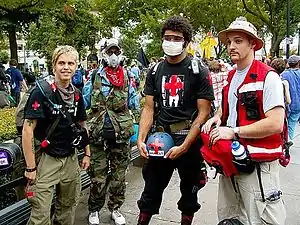Street medic
Street medics, or action medics, are volunteers with a minimum of first aid medical training supplemented by specific protest-related training, who attend protests and demonstrations as support or mutual aid roles to provide medical and wellness care. Unlike emergency medical technicians (EMTs) or paramedics, who have undergone education for professional medical care, street medics usually operate under Good Samaritan clauses and use methods learned through specific protest-medicine training programs which individuals are required to undertake in order to be recognized as a trained street medic.[1]

Street medics may treat trauma injuries, chemical agent and other crowd control weapon ailments, animal attacks, as well as general care for things like heat stress or cold exposure, epileptic seizures, and general well-being.
It is somewhat common that street medics are targeted by authorities for use-of-force and/or arrest, and some street medic collectives have been infiltrated by the police .
History

Street medics originated in the U.S. during the Civil Rights Movement and anti-war movement in the 1960s.[2] They conceived of medicine as self-defense, and provided medical support to the American Indian Movement (AIM), Vietnam Veterans Against the War (VVAW),[3] Young Lords Party, Black Panther Party, and other revolutionary formations of the 1960s and 1970s. Street medics were also involved in free clinics developed by the groups they supported. The street medic pepper spray removal protocol (MOfibA - Mineral Oil followed immediately by Alcohol) was later adopted by the U.S. military. Because the MOfibA protocol can cause severe damage to the patient if done incorrectly, it was largely replaced by the LAW (Liquid Antacid and Water) protocol.[4]
See also
References
| Wikimedia Commons has media related to Street medics. |
- Blanding, Michael (2003-02-20). "Medic!". The Boston Phoenix. Archived from the original on 2006-10-05. Retrieved 2006-10-23.
- Buccini, Cynthia K. (2010). "Street Medicine" (PDF). Bostonia. Boston University (Fall 2010): 47–51.
- Nicosia, Gerald (2001). Home to war : a history of the Vietnam veterans' movement. Crown Publishers. ISBN 0-8129-9103-6.
- Luis Manriquez (Director) (2004). Street Medic (DVD). Archival and new footage from the U.S., 1968-2004.CS1 maint: location (link)